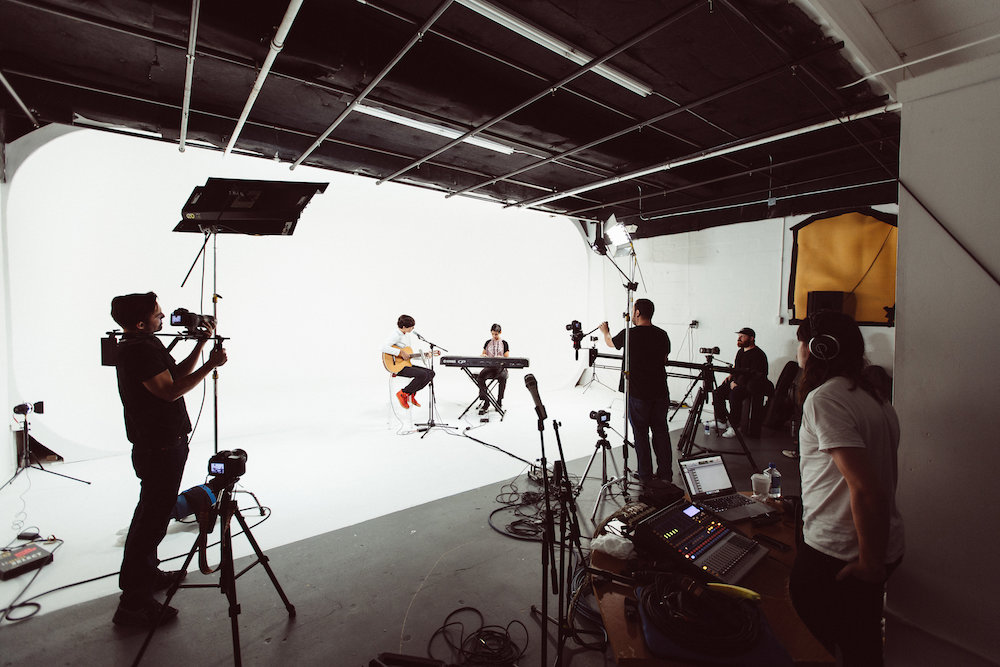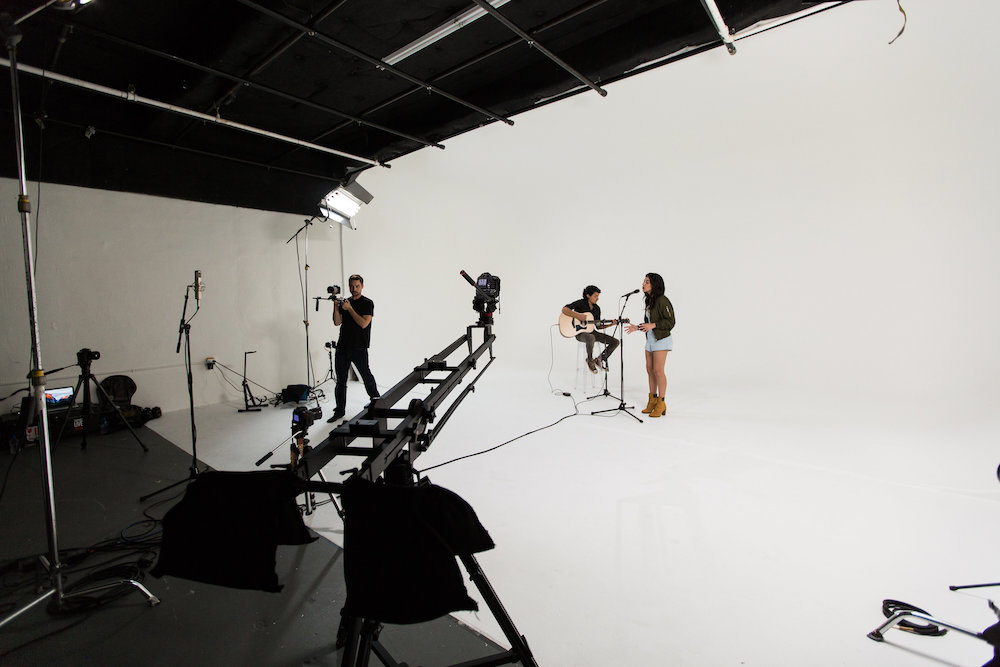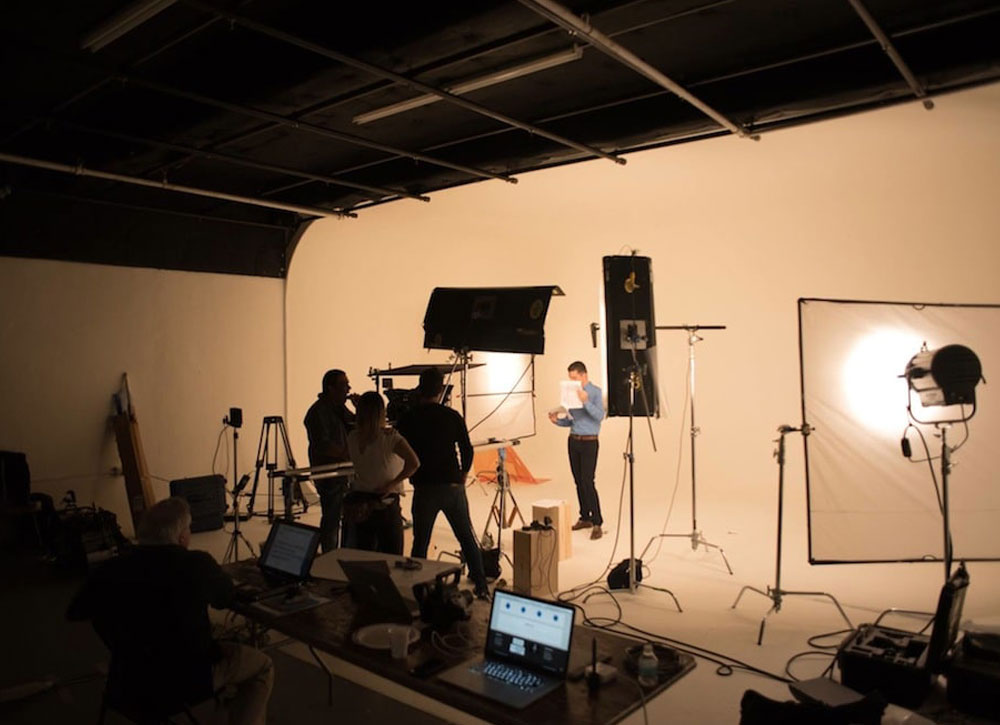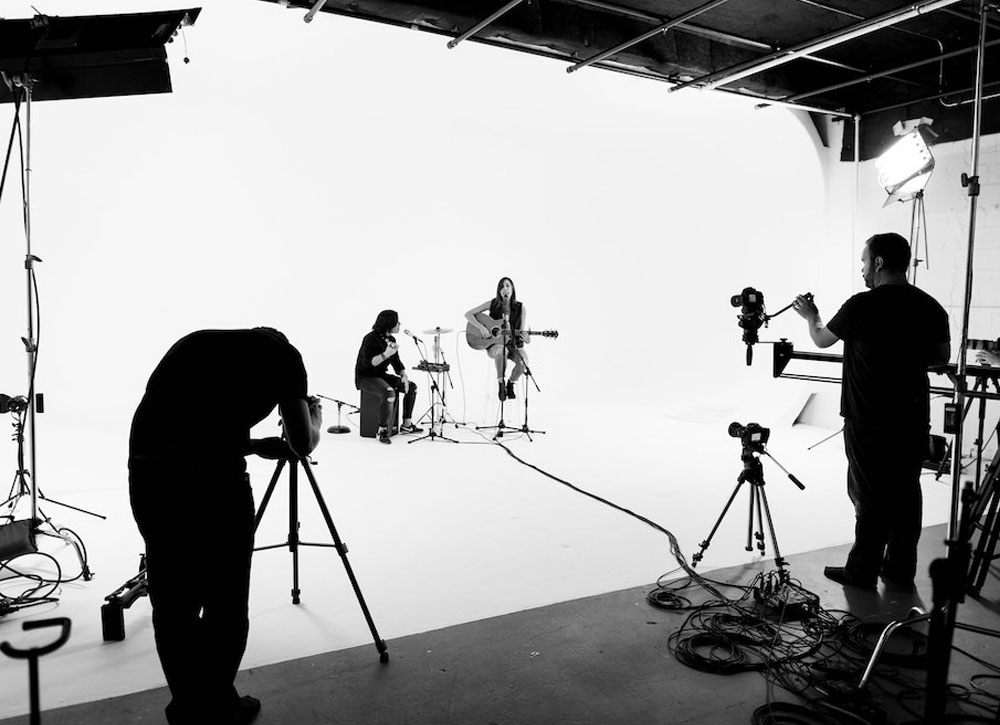Virtual Production
Discover seamless and efficient virtual production with M3 Studios, utilizing cutting-edge technology in the United States and beyond. Our innovative solutions cater to all your production needs, from real-time rendering and LED walls to motion capture and digital assets.

What is Virtual Production?
Virtual production is a way of combining digital and real-world filmmaking. It uses high-tech tools to create visual effects, virtual sets, and digital assets. The United States, China, India, Japan, and Germany are leaders in virtual production technology.
How Does Virtual Production Technology Work?
Virtual production technology uses several advanced methods:
- Real-time Rendering: Lets filmmakers see and change scenes instantly.
- Volumetric Capture: Captures real-world objects in 3D for virtual environments.
- LED Walls: Big screens that show realistic backgrounds during filming.
- Green Screen: A backdrop that can be digitally replaced with any scene.
Key Components of Virtual Production
Virtual production relies on several main parts:
- Game Engines: Software to create interactive 3D content.
- Motion Capture: Tracks actors’ movements to animate digital characters.
- Virtual Sets: Digital environments that replace physical sets.
- Digital Assets: Computer-made objects or characters.
- Visual Effects: Enhances or creates imagery outside live-action footage.

Benefits of Using Virtual Sets
Virtual sets have many benefits:
- Photorealistic Environments: Lifelike settings that enhance storytelling.
- Digital Backgrounds: Change scenes easily without rebuilding physical sets.
- Immersive Media: More engaging viewer experience.
- Previsualization: Plan scenes ahead to save time and money.

Understanding Volumetric Capture
Volumetric capture records real-world objects or people in 3D. It is essential for creating digital doubles and realistic virtual sets. This technology combines spatial computing and motion capture to bring new realism to virtual production.
This guide shows how M3 Studios uses cutting-edge technology to stay ahead in the entertainment industry. Filmmakers can create amazing and immersive media experiences by understanding and using virtual production.
The Role of Real-Time Rendering in Virtual Productions
Real-time rendering is crucial in virtual productions. It creates CGI and virtual sets instantly, allowing directors to make changes on the spot. This technology uses LED walls and motion capture to seamlessly blend actors into digital worlds.
What Are LED Walls and How Are They Used?
LED walls are big screens showing dynamic backgrounds during filming. They work with virtual production technology to replace green screens. Real-time rendering provides realistic virtual backgrounds that help actors interact with their environment better.
How Motion Capture Enhances Virtual Productions
Motion capture enhances virtual productions by tracking actors’ movements and translating them into digital characters. This includes:
- Digital Characters: Lifelike characters in CGI.
- Performance Capture: Capturing facial expressions and body language for authenticity.
- Real-Time Rendering: Integrating captured movements into the scene instantly.
Exploring Digital Assets in Virtual Production
Digital assets are key in virtual production technology. They include visual effects, game engines, CGI, and photorealistic environments. Digital characters and digital doubles help create immersive experiences. Countries like the United States, China, India, Japan, Germany, the United Kingdom, France, Italy, Canada, and South Korea are leaders in this field.
Role of Game Engines in Visual Effects
Game engines are crucial for making great visual effects. They allow real-time rendering and help build virtual sets. Animation software uses game engines, too. This tech is popular in the United States, China, India, Japan, Germany, the United Kingdom, France, Italy, Canada, and South Korea.
From CGI to Photorealistic Environments
CGI, or computer-generated imagery, turns into photorealistic environments using digital assets. Virtual backgrounds made with virtual production technology enhance the immersive media experience. This tech is common in the United States, China, India, Japan, Germany, the United Kingdom, France, Italy, Canada, and South Korea.

How Digital Characters and Doubles Are Created
Digital characters and digital doubles are made through motion capture and volumetric capture. Virtual production and 3D modeling are also important. The United States, China, India, Japan, Germany, the United Kingdom, France, Italy, Canada, and South Korea excel in these technologies.

Tools and Software for 3D Modeling and Animation
Popular Animation Software in the Industry
Animation software helps create 3D models, visual effects, and game engines. Top choices in the United States, Germany, and Japan include Blender, Autodesk Maya, and Cinema 4D. These tools allow artists to make amazing animations and complex visual effects for movies, games, and virtual reality.
Advantages of Virtual Cinematography
Virtual cinematography uses digital cameras and real-time rendering to create immersive media. This method is popular in the United States and France. It lets filmmakers explore new creative options. Benefits include saving money, flexible filming locations, and creating detailed, realistic scenes without physical sets.
Interactive Storytelling: Engaging Audiences
Interactive storytelling boosts audience engagement by letting viewers influence the story. Digital storytelling tools and virtual production technology create immersive experiences that captivate audiences. In the United States and South Korea, this approach offers new ways for creators to connect with their audience through engaging, interactive content.
Utilizing Cloud-Based Production Solutions
How Remote Collaboration Tools Are Shaping the Industry
Remote collaboration tools are changing the industry by enabling cloud-based production and virtual post-production. In the United States and India, tools like Slack, Zoom, and Trello help teams communicate and work together easily. These tools support digital pipelines, simplifying project management and remote collaboration.
Virtual Post-Production: Streamlining Processes
Virtual post-production uses cloud-based solutions to make processes faster. Game engines and visual effects software are key to this change. Studios use these technologies in the United States and the United Kingdom to improve efficiency and reduce production time. Virtual post-production allows teams to work on different parts of a project simultaneously, speeding up the whole process.
Managing Digital Pipelines Effectively
Managing digital pipelines is vital for successful virtual production and remote collaboration. Cloud-based production and production tracking software help streamline workflows. In the United States and Canada, tools like ShotGrid and Aspera help studios monitor progress and keep projects on track. Efficient management of digital pipelines ensures smooth operations and timely completion of tasks.
These modern tools and technologies are crucial in today’s media production. M3 Studios uses these advancements to deliver top-quality, innovative content.
Inside Virtual Studios: A New Approach to Filmmaking
Virtual production is changing how films are made, especially in the United States. With virtual studios and advanced virtual production technology, filmmakers can create amazing scenes without leaving their location. Real-time rendering allows for immediate visual effects, making media production software an essential tool for modern filmmaking.
Production Tracking Software: Keeping Projects on Track
Production tracking software is crucial for managing digital pipelines in virtual production. It helps keep every part of a project organized and allows teams to use remote collaboration tools effectively. By streamlining workflows, this software ensures that projects stay on schedule and within budget.
Live Compositing and Its Importance
Live compositing combines multiple visual elements in real time, a key feature of virtual production technology. This process uses real-time rendering to blend actors, CGI, and backgrounds seamlessly, creating stunning visual effects swiftly.
Innovations in Virtual Lighting
Virtual lighting has changed how scenes are lit in virtual sets. Using real-time rendering and CGI, filmmakers can adjust light conditions instantly. This offers more creative control and saves time during production.
Performance Capture and Digital Scenography
Performance capture and digital scenography are important for making lifelike characters and settings. Motion capture is widely used in China and the United States to create digital doubles and virtual backgrounds. This tech captures actors’ moves to bring digital characters to life.
How to Scout Virtual Locations
Virtual location scouting is now a big part of film production. Filmmakers can explore places without leaving their studios using virtual sets and real-time rendering. India and Germany have led the way in using green screens and other tech to create realistic backgrounds.
Best Previs Tools for Filmmakers
Previs tools are crucial for planning scenes and shots. Previsualization helps directors see how scenes will look before filming. Cloud-based production and virtual cinematography are popular in the United Kingdom and Canada. These tools allow detailed planning and teamwork.
Advances in Digital Storytelling and Hybrid Production
Digital storytelling and hybrid production are growing fields. Virtual post-production, digital pipelines, and live compositing are improving in France and Italy. These advances help filmmakers mix traditional and digital techniques to create unique stories.
What Is the Future of Virtual Reality Filmmaking?
Virtual reality filmmaking is growing with augmented reality and mixed reality production. Immersive media and previsualization techniques are improving. Interactive storytelling adds new layers. Leading countries in this area include the United States, China, India, Japan, Germany, the United Kingdom, France, Italy, Canada, and South Korea.
Augmented Reality vs. Mixed Reality Production
Augmented reality and mixed reality production use spatial computing to make visual effects and virtual production elements. These immersive experiences are being developed in many places, including the United States, China, India, Japan, Germany, the United Kingdom, France, Italy, Canada, and South Korea.
Innovations in Immersive Media
New ideas in immersive media like XR production, virtual reality filmmaking, and hybrid production are changing storytelling. Digital scenography is also part of this change. The United States, China, India, Japan, Germany, the United Kingdom, France, Italy, Canada, and South Korea led these advancements.
Trends in Previsualization Techniques
Previsualization techniques are improving with new previs and remote collaboration tools. Cloud-based production and digital pipelines are also important. These trends are seen in top countries like the United States, China, India, Japan, Germany, the United Kingdom, France, Italy, Canada, and South Korea.
M3 Studios offers insights and solutions for those looking to stay ahead in virtual production.
How Virtual Set Extension is Revolutionizing Production
Virtual set extension is a game-changer in virtual production. By using digital stagecraft, filmmakers can expand physical sets with virtual backgrounds. This technique creates immersive environments without the constraints of physical locations, opening new possibilities for storytelling.
Real-Time Collaboration Tools
Real-time collaboration is vital for teams working on complex projects from different locations. Remote collaboration tools enable seamless communication and coordination, ensuring everyone can contribute to the digital pipelines efficiently.
Use of Virtual Props in Productions
Virtual props are essential elements in modern productions. They complement virtual sets and photorealistic environments. These digital assets can be manipulated in any way needed, providing flexibility and enhancing the overall visual experience.
What Is Digital Stagecraft?
Digital stagecraft uses virtual sets, CGI, and advanced virtual production technology. It allows storytellers to create detailed worlds, pushing the boundaries of what’s possible in filmmaking.
Integrating Video Game Engines in Film Production
Video game engines have changed film production a lot. Engines like Unreal and Unity are used to make impressive CGI and visual effects. The United States and Germany now use video game engines in film more often. These tools help filmmakers create lifelike scenes quickly.
Exploring XR Production Techniques
XR production is changing movie-making. This includes virtual reality filmmaking, augmented reality in film, and mixed reality production. These methods let creators build new worlds in Canada and the United Kingdom. They mix real and digital elements to tell new kinds of stories.
Creating Immersive Experiences for the Audience
Creating immersive experiences means using interactive storytelling and spatial computing. Digital storytelling is popular in France and Italy. These tools let audiences become part of the story, making it more fun and memorable.
Designing with Production Design Software
Production design software is key for modern filmmaking. It includes previsualization, 3D modeling, and animation software. These tools in South Korea and Japan help designers plan scenes before filming starts. This saves time and resources, making production smoother.
FREQUENTLY ASKED QUESTIONS
What is Virtual Production?
Virtual production is a way of making movies that mix digital and real-world elements. It helps filmmakers see scenes and make changes instantly.
How does virtual production differ from traditional methods?
Traditional filmmaking separates filming and editing. Virtual production combines them, allowing for instant changes and better planning.
Can virtual production be used for all types of films?
Yes, it can be used for many kinds of films, from big movies to TV shows and animations. It’s great for complex scenes.
What are the benefits of using virtual production?
Virtual production saves money, gives quick feedback, and offers more creative choices. It also cuts down on location shoots and big-set builds.
Who produces the virtual environments for production?
At M3 Studios, our expert team creates realistic virtual environments for your projects, ensuring high quality.
How is virtual production being used in the industry today?
Many top studios and filmmakers use virtual production to improve their visual stories. It’s used in big movies and TV series.
Is virtual production suitable for small-scale projects?
Yes, virtual production can be adjusted for small projects. It offers the same creative and efficient benefits.
What technology do you need for virtual production?
Virtual production uses advanced tools like LED screens, motion capture systems, and strong computers. Our studio has all the latest tech for high-quality work.

Key Insights
- We specialize in making high-quality virtual production content for different media.
- Our team knows how to make cool virtual productions that fit your needs.
- Virtual production is changing how we make and show content.
- We are good at creating immersive virtual places that help tell a story.
- Our skill in virtual production helps blend it smoothly with regular filmmaking.
- The virtual productions we make meet top industry standards.
- By using advanced tech, we give innovative and efficient virtual production solutions.
- Making interesting virtual production experiences is what we do best.
